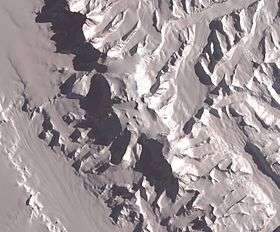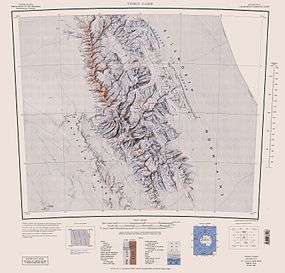Mount Tyree
| Mount Tyree | |
|---|---|
_from_East_by_Christian_Stangl_(flickr).jpg) Mount Tyree from East (Photo: Christian Stangl, 2011) | |
| Highest point | |
| Elevation | 4,852 m (15,919 ft) [1] |
| Prominence | 1,152 m (3,780 ft) [2] |
| Listing | Seven Second Summits |
| Coordinates | 78°24′42″S 85°51′43″W / 78.41167°S 85.86194°WCoordinates: 78°24′42″S 85°51′43″W / 78.41167°S 85.86194°W [2] |
| Geography | |
 Mount Tyree | |
| Parent range | Sentinel Range |
| Climbing | |
| First ascent | 1967 by Barry Corbet and John Evans, members of Nicholas Clinch's team |
| Easiest route | Rock/ice climb |

Mount Tyree (4852m) is the second highest mountain of Antarctica located 13 kilometres northwest of Vinson Massif (4,892 m), the highest peak on the continent. It surmounts Patton Glacier to the north and Cervellati Glacier to the southeast.
History
Mt. Tyree was discovered in January 1958 during reconnaissance flights by the United States Navy VX-6 squadron, and mapped later that month by the Marie Byrd Land Traverse Party. The mountain was named for Rear Admiral David M. Tyree, who was commander of the U.S. Naval Support Force in Antarctica, from April 14, 1959 to November 26, 1962.[1]
As of 2012, the summit has only been reached on five occasions, by a total of ten people, via three different routes: in January 1967 by John Evans and Barry Corbet (of Corbet's Couloir); in January 1989 by Terry ‘Mugs’ Stump; in 1997 by French alpinists Antoine de Choudens and Antoine Cayrol; and later in 1997 by Conrad Anker and Alex Lowe. On January 3, 2012 Hans Kammerlander, Robert Miller and Christian Stangl repeated the French route to make the fifth ascent. Out of ten mountaineers who successfully climbed Mt Tyree, three died in unrelated mountaineering accidents within four years of their respective ascents.[3] The still-unclimbed south face is 2,000 metres (6,600 ft) high and one of the largest walls in Antarctica.
The climbing season is November to January, when the sun is above the horizon 24 hours a day and the air is warmest—up to −30 °C (−20 °F) near the summit. Like the nearby Mount Vinson, the mountain may be accessed by the means of a 6-hour flight from Punta Arenas, Chile to Union Glacier Camp followed by a 200 km flight on a ski plane to the base of the mountain.
Ascents
| Number | Year | Climber |
|---|---|---|
| 1 | 1967 | Barry Corbet John Evans |
| 2 | 1985 | Mugs Stump |
| 3 | 1997 | Antoine Chayrol Antoine de Choudens |
| 4 | 1997 | Conrad Anker Alex Lowe |
| 5 | 2012 | Hans Kammerlander Robert Miller Christian Stangl |
Maps

- Vinson Massif. Scale 1:250 000 topographic map. Reston, Virginia: US Geological Survey, 1988.
- Antarctic Digital Database (ADD). Scale 1:250000 topographic map of Antarctica. Scientific Committee on Antarctic Research (SCAR), 1993–2016.
See also
References
- 1 2 U.S. Geological Survey Geographic Names Information System: Mount Tyree
- 1 2 "Mount Tyree, Antarctica". Peakbagger.com. Retrieved 2013-07-13.
- ↑ "Tyree - A History".
External links
- "Mount Tyree" on Mountain-forecast.com
- Photo of Mount Tyree on Secondseven.org
- "Mount Tyree" on Peakery.com
- Distant view of Tyree from Vinson on Summitpost.com